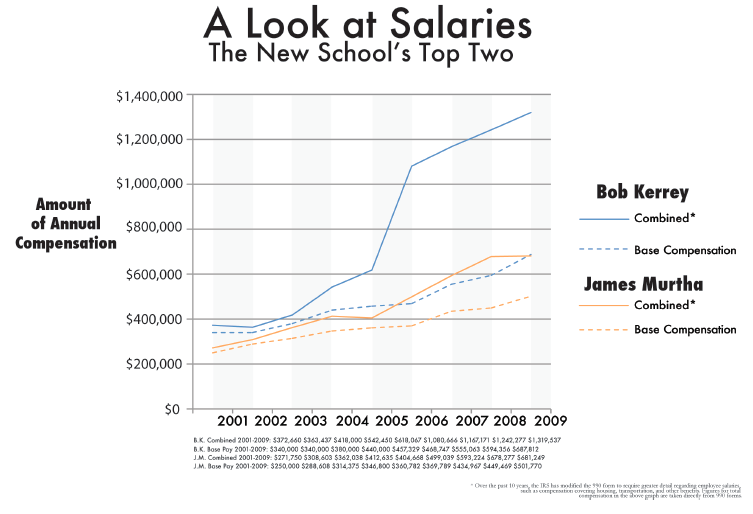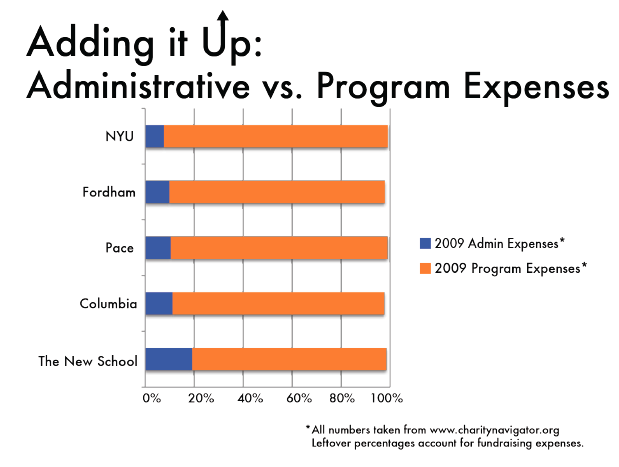On April 19, the Omaha World-Herald reported that over the past 15 months, The New School has paid former president Bob Kerrey as much as $916,000 — and that as president emeritus, a post he could hold until 2016, Kerrey stands to receive as much as $400,000 to $600,000 each year in salary and benefits from the university, unless he returns to the U.S. Senate next year.

The revelation comes at a time when The New School’s current administration is facing pressure from the university community regarding the institution’s financial transparency. At a New School for Social Research town hall on February 21, students questioned President David Van Zandt about the university’s administrative expenditures, as well as the salaries currently awarded to Kerrey and former Executive Vice President James Murtha. At the meeting, Van Zandt declined to detail such figures, citing confidentiality between the university and its employees.
At a subsequent town hall gathering in March, Parsons professor Cynthia Lawson asked Van Zandt about the chasm between administrative and faculty salaries. A second faculty member questioned how evenly the school’s expenditures are distributed, and bemoaned the lack of specificity in the annual financial reports available on The New School’s website.
“There is a widespread perception among faculty that our university has an inequitable and unequal salary scale,” Nidhi Srinivas, associate management professor at Milano, told the Free Press.
Much information pertaining to the university’s expenditures and investments remains shrouded in mystery. A number of answers, however, can be found in The New School’s annual IRS 990 forms, a document that all non-profit or tax-exempt organizations in the United States are required to file with the federal government. The New School, as a 501(c) organization, is tax-exempt; its mission statement states that the institution’s purpose is to advance education, as opposed to private interests.
The university’s 990 forms, which are available online, provide detailed information about The New School’s finances dating back to 2001 — including administrative salaries. An overview of the past decade reveals an upward trend in the rate of compensation awarded to New School administrators, resulting in present-day salaries comparable with those at institutions whose student bodies are far larger than The New School’s.
The global economic crisis that hit in 2008 had serious consequences for many institutions of higher education across the U.S. At some universities and colleges, senior administrators took pay cuts, turned down raises and bonuses, or donated large sums to charity. Yet the 990 declarations show that in the wake of the 2008 crisis, The New School did not curb administrative salaries.
Experts consider the 990 a reliable source of information about the finances of non-profit organizations. Frank Barletta, The New School’s senior vice president for finance and business, sat with the Free Press for an hour-long interview, and provided his insight into the 990 forms and the financial information they provide.
“The 990 form is an informational return, not a tax return,” noted Barletta. Since no taxes are due, the form is the principal way by which the IRS gathers information about tax-exempt organizations. “It shows the sources of the funds and where the money is being spent,” Barletta added. “It goes into more detail, even, than the financial statement does.”
****
Over the past decade, the IRS has substantially revised the 990 form with the goal of enhancing financial transparency within non-profit and tax-exempt organizations. One notable change required organizations to provide greater detail regarding their internal governance structures — details like the compensation provided to top administrators for housing and transportation.
The 990 forms account for the university’s expenditures for each fiscal year, which spans from July 1 to June 30. As such, The New School’s most recent financial report details the year ending on June 30, 2010. More recent financial information, such as the salary that President David Van Zandt has received since arriving at The New School in January 2011, is not yet available; according to Frank Barletta, the university will send its 990 form accounting for the 2010-11 fiscal year to the IRS by May 15. The Free Press obtained the documents through the independent non-profit information websites GuideStar and Charity Navigator, organizations that make such records available to the public.
Between the years 2001 and 2010, when Kerrey was in office, The New School underwent a major renovation and rebranding effort. The university’s endowment, as well as its revenues, increased dramatically — a 79.5 percent increase in assets during Kerrey’s tenure, which accounts for the school’s revenue, endowment, and total financial holdings.
Over this period, the university’s expenditures also increased, particularly in the amounts awarded to top administrators. In 2001, Kerrey’s base compensation was $340,000. By 2009, it had increased to $687,812.
As president, Kerrey was entitled to live in the elegant, university-owned townhouse on W. 11th St. between Fifth and Sixth Avenues. Kerrey lived in the house, which Van Zandt currently resides in, throughout his time at The New School. The president’s estimated housing fees, which according to Barletta, the senior vice president for finance and business, exceeded $400,000, are included on the 990 form as “estimated amount of other compensation from organization and related organizations” alongside other expenses — information that the IRS did not require before 2008. In 2009, Kerrey’s total deferred compensation amounted to $631,725.
According to Barletta, New York City’s notoriously high real estate values are to blame. “This is Greenwich Village,” he said. “For the president of the University of Montana, for example, the number would be much lower.”
Robert Kittine, Jr., a senior associate broker for Corcoran Real Estate who sells real estate in Greenwich Village, estimated that a four-story townhouse on West 11th Street would cost “$22,000 to 23,000 a month.”
Kerrey’s total compensation for 2009, including housing expenses, was $1,319,537.
In comparison, New York University president John Sexton’s total salary that year was $1,513,723. At the same time, NYU’s revenue amounted to $3.4 billion dollars, while The New School’s stood at just under $400 million. At Ithaca College, an upstate New York institution with revenue and assets similar to The New School’s, President Thomas Rochon earned $407,590 in 2009.
In the wake of the 2008 financial crisis, many universities in New York curbed the trend in administrative salaries and decreased the amount awarded to senior administrators, according to these institutions’ own 990 forms. In 2009, five top administrators at NYU, including Sexton, saw an average cut of 4 percent from their previous base salaries. Pace University, meanwhile, cut the base salaries of five top administrators, including President Stephen Friedman, by an average of 7 percent. At The New School, however, five of the highest compensated and longest-serving administrators — including Kerrey and Murtha — received an average raise of 12 percent between the fiscal years 2008 and 2009.
Kerrey did not respond to a Free Press request to comment on this article. Murtha declined to comment.
In 2009, according to The Chronicle of Higher Education, Kerrey was the fourth highest-paid private college president in the state of New York. Ranked higher were the presidents of Rensselaer Polytechnic Institute, Columbia University, and New York University — with all four presidents earning between $1.3 to $1.7 million. While RPI, Columbia and NYU all hold billions of dollars in assets, The New School’s latest reported total assets for the year ending in June 2010 totalled less than $600 million.
“It’s clear from the limited information publicly available that we have a grossly overpaid senior administration,” said NSSR doctoral candidate Chris Crews, the sole student representative on the university’s Advisory Committee on Investor Responsibility. “While President Van Zandt has taken steps to cut some of this fat off the university hog, the senior leadership stills needs a few more trips to the butcher.”
****
From 2003 to 2011, The New School has spent between 19 to 27 percent of its total budget on administrative expenses per annum. Other universities in the city reported considerably lower percentages; New York University consistently spent around 7 percent of its budget on administrative expenses during the same period.
The New School’s program expenses, however, were lower than those of many other schools in the city during this time. Program expense percentages reveal how much a non-profit organization spends on its reported mission — in this case, education. The New School spent roughly 77 percent of its budget on program expenses each year over the past decade, while NYU’s expenditures were consistently close to 91 percent throughout the same period. For other universities in New York City, program expenses were nearly always over 85 percent, while administrative expenses ranged from 8 to 15 percent — a significant difference from The New School’s figures.

A number of factors could explain the salary increases for New School administrators. According to Mark Lipton, a management professor at The New School for Public Engagement, one reason could be a greater workload and more job responsibilities.
“While it’s important to look at salaries, it’s equally important to look at the weight that people are carrying in many of these positions,” said Lipton. “Support staff for many high-priced administrators has been reduced significantly and their load is therefore much greater than before or during the worst of the financial crisis.”
The steady rise in administrative salaries, however, has caused concern among faculty and staff. When asked about transparency regarding salaries at the March 20 town hall, President Van Zandt expressed interest in working with the faculty senate to find a solution.
Milano professor Nidhi Srinivas, a co-chair on the Faculty Senate for the 2010-11 academic year, told the Free Press that the Senate asked the administration for “greater information on salary scales within our university” at the time, in order to “clear the air on this issue.” Srinivas added that the Senate “also asked for information on how [The New School] compared with others in the New York City region.” According to Srinivas, the university did conduct “studies on both these topics,” but has yet to release its findings. “Nor
did we receive a response to our requests that year,” Srinivas said.
Frank Barletta, however, said that in his estimation salary increases have occurred across the entire university.
“I would say with the exception of a reshuffling,” said Barletta, referring to the university’s recent history of job changes at its highest levels, “[administrative] salaries have been going up about the same rate as staff and faculty,” adding that “In the past we were giving out, on average, 4-percent salary raises.”
When asked, however, if faculty or staff have also received a 4-percent salary increase, Barletta replied, “Approximately, yes,” but not in the “last couple of years.” The reason, he said, was that “we just don’t have enough funds in the budget.”
The divergence between administrative and faculty salary increases is not exclusive to The New School. According to Andrea Fuller, a news researcher at The Chronicle of Higher Education, it has become common among institutions of higher education.
“There is a generally seen trend of executive pay increasing faster than faculty pay,” said Fuller.
In an email to the Free Press, Van Zandt declined to comment on the information provided in the 990s. It would be “inappropriate for me to comment in any detail on the school’s finances prior to the start of my tenure,” Van Zandt wrote. The president noted, however, that the administration had recently “reorganized the leadership structure” and “streamlined operations in several areas starting at the top,” which had resulted in “almost $2.5 million in cost savings.”
“I am committed to achieving a long-term financial and operational structure that emphasizes quality, service to students, and organizational effectiveness,” Van Zandt wrote. “Part of this involves an ongoing analysis of our administrative expenses, including structure [and] compensation levels.”
Reporting by Will Carter, Martina Gordon, Heather Pusser, and Kareem Samuels







Leave a Reply